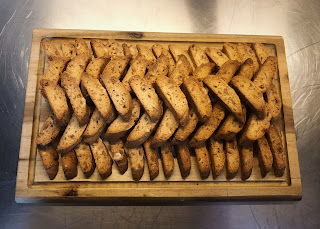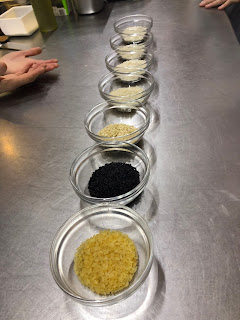Dolci Italiani
In Italy, there are many cakes or even desserts during meals. For different festivals, though, there are specific pastries/sweets. For Christmas, a lot of the traditional desserts are baked, while for carnival, they are fried desserts. While it is cold, the pigs are slaughtered, then at carnival time (end of January into February) the pork fat is used for frying. I found this very interesting because of the cross connection it has been the slaughtered houses and pastries, but it does make a lot of sense. In Italy, there is ultimately no waste, therefore they want to use the pork fat while it is the best.
Over the years, desserts have become more popular because they are easier to produce and they are part of the "trend." Although each region of Italy is known for certain pastries and desserts, there are often overlaps as well. This is due to the fact that years ago, there was little to no traveling out of their region, therefore you did not see what else was out there. Now, people are very proud of their region's creations and they believe it is the traditional way.
I found gelato to have a very interesting history that I would like to share:
During the time of the Egyptians, there was a kind of "gelato" being enjoyed that was really just snow and fruit. Then, Alexander the Great had his soldiers bring him snow and then he would mix in fruit. In the Roman times, they would crush ice and mix it with honey or fruit. The wealthy people had a special place for their snow and ice to be kept in their house. But during the Middle Ages, gelato sort of got lost for 4-5 centuries until the Arabs brought it back as "sherbet" a word in Arabic that means sweet ice. Caterina di Medici had a competition every year where they wanted to see the most interesting food, something they had never seen before. A guy won the competition by making sherbet made with fruit and crushed ice. Mrs. Medici brought him to France with her and introduced the French to sherbet.
Gelato is not the only Italian dessert of course, so here are some more, the region that they are from, and some information I research about each:
Monte Bianco: Piemonte & Valle D'Aost
This dessert is actually popular in France as well, mainly because they share a border and also Mont Blanc, the highest mountain in Europe. This dessert is made with chestnuts, whipped cream, and chocolate and is shaped like a mountain covered in snow. This dessert is not overly sweet because it is very balanced with the chestnut puree' and creaminess of the whipped cream, it is absolute perfection.
Castagnaccio: Liguria
The main ingredients of this chestnust based "cake" are water and chestnut flour and is often enjoyed more in the autumn time of the year. This dessert dates back when it was considered a dish for poor people in the mountains of the Apennines because chestnut were a staple food for tuscan peasants.
There is a romantic legend that says that the rosemary in the Castagnaccio is used as a perfume and it is a powerful love elixir. This means that eating the "cake" should make you fall in the love with the person that prepared it.
Pannettone: Milano, Lombardia
In the early 20th century, 2 Milanese bakers started to produce panettone for all of Italy. In 1919, Angelo Motta started producing his brand of cakes and developed the traditional panettone with the tall domed shape. This meant that he had to make the dough rise 3 times for almost 20 hours before cooking! The recipe was then changed again by Gioacchino Alemagna. The competition between these 2 bakers led to the industrial production of pannettone. By the end of World War II, pannettone was cheap enough for anyone to purchase.
Tiramisu: Veneto
Tiramisu is a fairly young dessert dating back to the 1960s at the restaurant Le Beccherie in Treviso, Veneto, which is probably where the name came from. There is another account that says towards the end of the 17th century, the cake was produced in Siena in honor of Grnd Duke Cosimo III.
Sfogliatella (Riccia/Fritti): Naples
The sfogliatella Santa Rosa was created in the monastery of Santa Rosa in the province of Salerno Italy in the 17th century. In 1818, Pasquale Pintauro, a pastry chef, got the original recipe and began selling the pastries. Sfogliatella riccia is the traditional one and is very labor intensive. The sfogliatella fritti is less labor intensive and uses a shortcrust dough and doesnt have the traditional layers.
Fruit Martorana (Marzipan): Sicily
The marzipan fruits are made because Sicily has a lot of almonds that they need to use. Marzipan is made with almost all almond paste, therefore this is why these fruits were made. They are labor intensive to make, but absolutely adorable!
Today Logan & I made Tozzetti, which is similar to the biscotti we know in the US. Here biscotti means cookie, not a specific type. This is made with sugar, almonds, hazelnuts, anise seeds, pork fat, eggs, flour, sambuca, white wine, lemon zest, and baking powder. The taste was incredible and the crunch from the hazelnuts and almonds added another element. If I was to make these again, I would maybe try a different liquor, a darker one, that would add more flavor to the tozzetti. I felt as if the sambuca did not add much to the flavor of it, whereas a darker liquor might add a more caramelized note to it.
With Love,
Baylee
Over the years, desserts have become more popular because they are easier to produce and they are part of the "trend." Although each region of Italy is known for certain pastries and desserts, there are often overlaps as well. This is due to the fact that years ago, there was little to no traveling out of their region, therefore you did not see what else was out there. Now, people are very proud of their region's creations and they believe it is the traditional way.
I found gelato to have a very interesting history that I would like to share:
During the time of the Egyptians, there was a kind of "gelato" being enjoyed that was really just snow and fruit. Then, Alexander the Great had his soldiers bring him snow and then he would mix in fruit. In the Roman times, they would crush ice and mix it with honey or fruit. The wealthy people had a special place for their snow and ice to be kept in their house. But during the Middle Ages, gelato sort of got lost for 4-5 centuries until the Arabs brought it back as "sherbet" a word in Arabic that means sweet ice. Caterina di Medici had a competition every year where they wanted to see the most interesting food, something they had never seen before. A guy won the competition by making sherbet made with fruit and crushed ice. Mrs. Medici brought him to France with her and introduced the French to sherbet.
Gelato is not the only Italian dessert of course, so here are some more, the region that they are from, and some information I research about each:
Monte Bianco: Piemonte & Valle D'Aost
This dessert is actually popular in France as well, mainly because they share a border and also Mont Blanc, the highest mountain in Europe. This dessert is made with chestnuts, whipped cream, and chocolate and is shaped like a mountain covered in snow. This dessert is not overly sweet because it is very balanced with the chestnut puree' and creaminess of the whipped cream, it is absolute perfection.
Castagnaccio: Liguria
The main ingredients of this chestnust based "cake" are water and chestnut flour and is often enjoyed more in the autumn time of the year. This dessert dates back when it was considered a dish for poor people in the mountains of the Apennines because chestnut were a staple food for tuscan peasants.
There is a romantic legend that says that the rosemary in the Castagnaccio is used as a perfume and it is a powerful love elixir. This means that eating the "cake" should make you fall in the love with the person that prepared it.
Pannettone: Milano, Lombardia
In the early 20th century, 2 Milanese bakers started to produce panettone for all of Italy. In 1919, Angelo Motta started producing his brand of cakes and developed the traditional panettone with the tall domed shape. This meant that he had to make the dough rise 3 times for almost 20 hours before cooking! The recipe was then changed again by Gioacchino Alemagna. The competition between these 2 bakers led to the industrial production of pannettone. By the end of World War II, pannettone was cheap enough for anyone to purchase.
Tiramisu: Veneto
Tiramisu is a fairly young dessert dating back to the 1960s at the restaurant Le Beccherie in Treviso, Veneto, which is probably where the name came from. There is another account that says towards the end of the 17th century, the cake was produced in Siena in honor of Grnd Duke Cosimo III.
Sfogliatella (Riccia/Fritti): Naples
The sfogliatella Santa Rosa was created in the monastery of Santa Rosa in the province of Salerno Italy in the 17th century. In 1818, Pasquale Pintauro, a pastry chef, got the original recipe and began selling the pastries. Sfogliatella riccia is the traditional one and is very labor intensive. The sfogliatella fritti is less labor intensive and uses a shortcrust dough and doesnt have the traditional layers.
Italian Word of the Day: Riccia means curly
The marzipan fruits are made because Sicily has a lot of almonds that they need to use. Marzipan is made with almost all almond paste, therefore this is why these fruits were made. They are labor intensive to make, but absolutely adorable!
Today Logan & I made Tozzetti, which is similar to the biscotti we know in the US. Here biscotti means cookie, not a specific type. This is made with sugar, almonds, hazelnuts, anise seeds, pork fat, eggs, flour, sambuca, white wine, lemon zest, and baking powder. The taste was incredible and the crunch from the hazelnuts and almonds added another element. If I was to make these again, I would maybe try a different liquor, a darker one, that would add more flavor to the tozzetti. I felt as if the sambuca did not add much to the flavor of it, whereas a darker liquor might add a more caramelized note to it.
With Love,
Baylee




Comments
Post a Comment